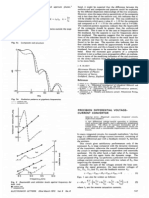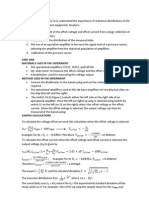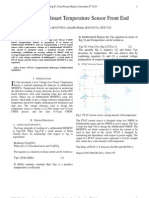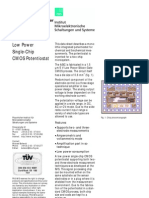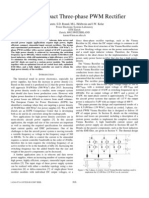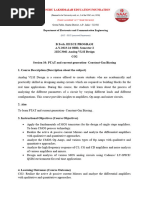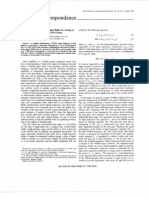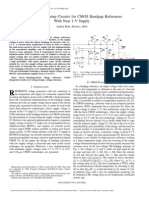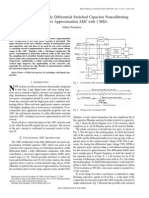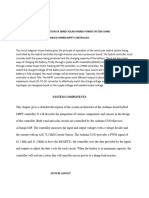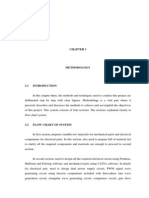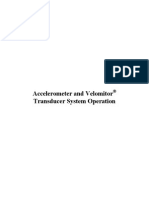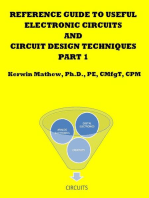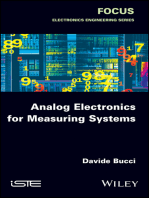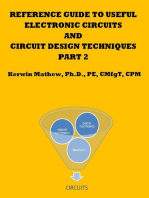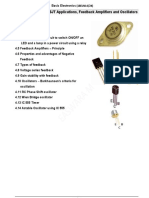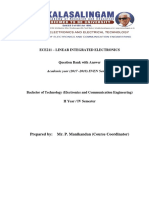Ieee Bakker 1996
Ieee Bakker 1996
Uploaded by
kurabyqldCopyright:
Available Formats
Ieee Bakker 1996
Ieee Bakker 1996
Uploaded by
kurabyqldOriginal Description:
Copyright
Available Formats
Share this document
Did you find this document useful?
Is this content inappropriate?
Copyright:
Available Formats
Ieee Bakker 1996
Ieee Bakker 1996
Uploaded by
kurabyqldCopyright:
Available Formats
-
IEEE JOURNAL OF SOLIII-STATE CIRCUITS, VOL. 31, NO. 7, JULY 1996
933
Micropower CMOS Temperature Sensor with Digital Output
Anton Bakker and Johan H. Huijsing, Senior Member, IEEE
Abstract-A CMOS smart temperature sensor with digital output is presented. It consumes only 7 gW. To achieve this extremely low-power consumption, the system is equipped with a facility that switches off the supply power after each sample. The circuit uses substrate bipolars as a temperature sensor. Conversion to the digital domain is done by a sigma-delta converter which makes the circuit highly insensitive to digital interference. The complete system is realized in a standard CMOS process and measures only 1.5 mm2. In the temperature range from -40 to +12QC, the inaccuracy is 3 ~ 1 C after calibration at two temperatures. The circuit operates at supply voltages down to 2.2 V.
TABLE I TARGET SPECIFICATIONS
I Min. I
Supply voltage
Average supply current (3V, 2 samples/sec)
Nom.
I Max. I
4.0
Unit
2.4
3.0
V PA
3
-40
Range
130
21
"C
Error
Bandwidth
OC
sampleslsec
I. INTRODUCTION
OW-COST' high-performance temperature sensors are increasingly required for the following applications: 1) on VLSI chips to control the dissipation; 2 ) in microsystems to compensate for temperature cross sensitivity of other sensors; 3) in strongly automated production plants; and 4) in automated consumer products like cars and domestic appliances. Next to the demands on costs and performance, it is also needed to reduce the power consumption of the temperature system to a minimum. The reasons for this are to be able to use the sensor in battery operated products, to reduce the errors caused by self-heating, and to be able to add the sensor to a VLSI chip without causing a significant increase in power consumption of the complete system. The micropower CMOS smart temperature sensor described here perfectly fits in this low-cost, high-performance, and lowpower market. It has its application in the automotive industry, where it is meant to measure the temperature in car tires. This is first for safety reasons and second to compensate for the temperature sensitivity of a pressure sensor which is also located in the tire. Krummenacher and Oguey [ l ] presented a smart CMOS temperature sensor with a power consumption of 120 pW. For our application, however, the power consumption should not exceed 10 p W . This is required to guarantee a lifetime of the battery of at least seven years, which is equal to the maximum lifetime of the tire. Another important disadvantage of the circuit of Krummenacher and Oguey is that they use a lateral bipolar transistor as
Manuscript received December 4, 1995; revised February 5 , 1996. This work was supported by the European Committee (ESPRIT Project 9011, acronym Slopsys). The authors are with the Delft Institute of Microelectronics and Submicron Technology (DIMES), Delft University of Technology, 2628 CD Delft, The Netherlands. Publisher Item Identilier S 001 8-9200(96)04470-8.
a temperature sensor. This device can only be used in special processes. We decided to use the substrate transistor, which is much more compatible with standard CMOS technology. This implies, however, the design of a complete new circuit topology, including offset-reduction techniques. Without degrading the accuracy too much, we obtained a power consumption of 60 pW at continuous operation. Including a power-down facility, this could be reduced to 7 pW at a nominal sample rate of 2 samplesh. The complete temperature measurement system consists of a temperature sensor, a bandgap voltage reference, and an analog to digital converter on one single chip. The interface to an external microcontroller is 8 b parallel. The target specifications are shown in Table I.
11. INTEGRATED TEMPERATURE SENSORS
In CMOS technology, there are three possible devices which can be used as a temperature sensor: 1) CMOS transistors operating in weak inversion; 2) lateral bipolar transistors; 3) vertical bipolar transistors. Vittoz [2] showed that it is possible to make voltage references using CMOS transistors operating in weak inversion. However, for temperature sensing, these devices suffer from limited reproducibility on absolute value and temperature coefficient, which are both depending on the threshold voltage. A lateral bipolar transistor can be used to make an accurate temperature sensor [l], [3]. The quality of the lateral bipolar transistor depends heavily, however, on the IC process. In many processes, especially when no attention has been paid to optimize this device, the current gain of this transistor is very low (< 5) and the leakage current toward substrate (via
0018-9200/96$05.00 0 1996 IEEE
934
IEEE JOURNAL OF SOLID-STATE CIRCUITS, VOL. 31, NO. 7, JULY 1996
220
\;tat
320
420
600
--+T(K)
Fig. 1.
Derivation of
and I/;'f.
Fig. 3. PTAT circuit with chopper
'
vss
Fig. 2. Basic PTAT circuit
vss Fig. 4. Simplified schematic of complete analog interface.
the parasitic vertical bipolar) is difficult to control and can be up to 50%. Considering also that data on these parameters is hard to obtain, good circuit design with these devices is hardly feasible. The vertical bipolar substrate transistor seems to be the best candidate for integrated temperature sensors [4]. The quality of this transistor is comparable to transistors in standard bipolar processes. The characterization of these devices may not be very elaborate in most processes, but is usually sufficient for our purpose. The main problem is the lack of a free collector terminal, which is inherently connected to substrate. This problem can, however, be solved on circuit level.
At an emitter current density ratio of eight, the temperature coefficient of this PTAT voltage is 0.2 mV/"C. Amplifying this voltage (uAVb,) and adding it to a base-emitter voltage (&,I) results in a so-called bandgap reference voltage independent of temperature (V,,f). B. A-D Conversion
EA converters have proven to be very suitable in lowfrequency, high-performance applications. In our case, having a very low-frequency signal (< 2 Hz) and moderate accuracy (8 b) a first-order EA converter has been chosen because of the lower complexity and die area compared to higher order EA converters.
C. Calibration Because a microprocessor is already needed to control the transmitter for the tire control application, it will be cheaper to implement the calibration facility in this microprocessor than to do a laser trimming or digital calibration on the chip. At this moment. a choice still needs to be made whether to implement the calibration figures in EEPROM, PROM, or even in RAM. This is mainly dependent on the quality of EEPROM at high temperatures (130C) and long lifetime (over seven years).
111. SYSTEM DESIGN A. Derivation of Temperature and Reference Signals
The method to derive temperature and reference signals from bipolar transistors has been published extensively [5]-[7]. The design methodology is shown in Fig. 1. The base-emitter voltage Vbc of a bipolar transistor decreases almost linearly with temperature. The temperature coefficient is approximately -2 mV/OC. This temperature coefficient is dependent on the emitter current density. The difference between two base-emitter voltages is in a first-order approximation linearly proportional to absolute temperature and can be written as
IV. CIRCUIT IMPLEMENTATION
A . PTAT Circuit
where p is the emitter current density ratio, k is Boltzmann's constant, and q is the electron charge.
The basic schematic for a CMOS PTAT circuit is shown in Fig. 2. Because the collectors of the substrate bipolars are connected to the substrate, an operational amplifier i s required to regulate the emitter currents. The offset drift of this CMOS amplifier is, however, in the order of the
BAKKER AND HUIJSING: MICROPOWER CMOS TEMPERATURE SENSOR WITH DIGITAL OUTPUT
935
bitstream
Fig. 5. Schematic of first-order current-mode ZA converter.
ck-in
4G-t
'temp
sensor reference I ref
bias
EA converter
1
I +
timer
reset /enabl enable e-' sample-ready
counter
I
I
ower-on
control
I
Fig. 6. Block schematic of complete temperature system.
required accuracy (1C M 200 p V ) which makes an offset compensation technique necessary. There are two topologies for offset compensation: Autozeroing and chopping [8]. The autozeroing technique is more complicated to combine with a current-mode EA converter, because of the not continuously available output signal. A choice has therefore been made to implement the chopping technique.
B. Chopper Circuit
The PTAT circuit with chopper is shown in Fig. 3. The opamp, as schematically shown in Fig. 2, consists of two amplifying stages. The first stage of the opamp is formed by . . . M8, while the second one is formed by Mg. The Miller capacitor C,, is needed for stabilization of the circuit. The chopper circuit is usually placed across the entire opamp. In our case, however, the chopper is placed only across the first stage of the opamp including the mirror. The offset of the mirror is therefore also removed. The advantage of
Fig. 7. Micrograph of' the realized chip.
not placing the chopper across the complete opamp is that the second (Miller compensated) stage acts as a low-pass
936
IEEE JOURNAL OF SOLID-STATE CIRCUITS, VOL. 31, NO. 7 , JULY 1996
chi0 1 4
error
(c)
t:
0
-1 -2
-20
-3
-4
-5
-6
-7
Fig. 8. Error before calibration
(c) 1.0 1.5 ............................................................................................................
error
chip 2 chip 1 chip 3
-0.5 -1.0
I I I I
I I
I
I
I
I
-40
-20
20
40
60
80
100
120
-T
Fig. 9. Error after calibration at - 2 O O C
and 100C.
(c)
filter, which makes an additional low-pass filter unnecessary. Another advantage is that the lack of an additional low-pass filter also increases the bandwidth of the complete system. This circuit is patent pending [SI.
D. A-D Converter
The principle of the first-order EA converter is shown in Fig. 5. The bitstream at the output is proportional to Itemp/Iref. This signal is led to a counter, which acts as a first-order digital decimation filter. The integrator is reset at the start of each sample. The value of the capacitor is 60 pF.
C. Analog Interface Electronics
A simplified schematic of the analog interface is shown in Fig. 4. The left part is the PTAT circuit. The base-emitter voltage of Q 2 is transformed into a current by Rbe. The reference current Iref is the addition of the current through M2, which is PTAT and the current through M4, which is proportional to Vbe, thus making a current independent of temperature. The temperature dependent current Itelnp is formed by the PTAT current through A.49 minus a small current b , to shift the point at which Itemp is zero proportional to V from -273C (0 K) to -61C. This is done to enlarge the useful range of the EA converter. The choice for -61C as a lowest temperature point is mainly dictated by the need to have a ratio, which makes an accurate scaling of the current mirrors possible. The values of RPtatand Rbe are 110 kR and 560 kR,respectively, which are relatively large, but needed to reduce power consumption. The opamp which is used to generate the current proportional to V , , , does not need to be chopped because the offset drift is fairly small compared to the signal (1C = 2 mV).
E. Complete Temperature System
A block schematic of the entire temperature system is shown in Fig. 6. The control block is needed to control the powerdown mode and the counter. The clock signal has to be divided by two to guarantee a precise 50% duty-cycle, which is needed for the chopper. Both the digital and the analog part can be switched off by the power-on signal.
F. Layout Design and Fabrication
The circuit has been realized in a double-poly 2 pm CMOS process. Special attention has been paid to the matching of transistors and resistors. The complete circuit measures I .5 mm2 (excluding bond pads), of which 20% is occupied by poly resistors and 10% by poly-poly capacitors. A micrograph is shown in Fig. 7. This chip, which measures 12 mm, also incorporates the pressure sensor interface, which is needed for the tire control application. The analog part of the temperature system is marked by a white rectangle. A second version is
BAKKER AND HUIJSING: MICROPOWER CMOS TEMPERATURE SENSOR WITH DJGITAL OUTPUT
937
errors. The total residual error will then be due to the offset in the base-emitter voltage of the bipolar temperature sensor, which will be h3C. The required accuracy of *lC can then be met with a single calibration of Vbe at room temperature.
Supply current Average (3V. 2 sampleskc) During sample
ACKNOWLEDGMENT
25
The authors wish to thank F. R. Riedijk for fruitful discussions.
120
51
C
Range
-40
REFERENCES
P. Krummenacher and H. Oguey, Smart temperature sensor in CMOS
technology, Sensors and Actuators, vols. A21L.423, pp. 636-638, 1990. E. A. Vittoz, A low-voltage CMOS bandgap reference, IEEE J. SolidState Circuits, vol. SC-14, pp. 573-577, 1979. -, MOS transistors operated in the lateral bipolar mode and their application in CMOS technology, IEEE J. Solid-State Circuits, vol. SC-18, pp. 273-279, 1983. M. Ferro, F. Salerno, and R. Castello, A floating CMOS bandgap voltage reference for differential applications, IEEE J. Solid-State Circuits, vol. 24, pp. 690-697, 1989. G. C. M. Meijer, Thermal sensors based on transistors, Sensors and Actuators, vol. 10, pp. 103-125, 1986. G. C. M. Meijer, A. J. M. B o o d a m p , and R. J. Duguesnoy, An accurate biomedical temperature transducer with on-chip microcomputer interfacing, IEEE J. Solid-State Circuits,vol. 23, pp. 1405-1410, 1988. F. R. Riedijk and J. H. Huijsing, An integrated absolute temperature sensor with sigma-delta A-to-D conversion, Sensors and Actuators, vol. A34, pp. 249-256, 1992. C. C. Enz, E. A. Vittoz, and F. Krummenacher, A CMOS chopper amplifier, IEEE J. Solid-State Circuits, vol. SC-22, pp. 335-342, 1987. A. Bakker and J. H. Huijsing, Chopper amplifier with internal filter, Dutch patent application no. 10.01231, Sept. 18, 1995.
Error
Resolution
C
bits
PSR
Noise
Bandwidth
!
0.1
0.1
CN
C
50 samples/sec
currently being processed in a state-of-the-art 0.7 pm process, and measures only 0.7 mm.This reduction could be reached mainly by resizing the digital part and by replacing the poly resistors of 25 Q/U by high-resistive (undoped) poly of 2 kS1/0.
RESULTS V. MEASUREMENT
The chip has been encapsulated in a standard IC package and has been exposed to temperatures in the range from -40 to +120C. The circuit is working at supply voltages varying form 2.2 to 5.0 V. The current consumption is 25 pA at continuous operation (50 samplesk) and 3 p A at a sample rate of 2 samplesh, thus having a nominal power consumption of 3 /LA * 2.2 V = 7 pW. Due to the cascoding of all current mirrors and bias circuits, the power supply rejection is limited to O.IC/V, which is very good for circuits operating at voltages as low as 2.2 V. The noise is only 0 . 1 C over the entire temperature range. The specifications of the measured circuit are shown in Table 11. The error over temperature before calibration is shown in Fig. 8. The error is below h 7 C for the entire temperature range for three samples, which is in accordance with the calculated error of k 8C. Fig. 9 shows the error after calibration at -20C and 100C. This shows that the residual error after calibration is h1C. VI. CONCLUSION
Anton Bakker was born in Amsterdam, The Netherlands, on July I I , 1968 He received the M Sc. degree in electrical engineering from the Delft University of Technology, Delft, The Netherlands, in 1991. Since then, he has been involved in the development of mixed-mode analog-digital circuits on digitdl gate-arrays In 1993, he joined the Electronic Instrumentation Labordtory at the Delft University of Technology where he is now working toward the Ph.D degree on the Subject of CMOS temperature microsystems
A smart temperature sensor has been presented which offers extremely low power consumption and small chip area. The circuit has been made in standard CMOS technology. Calibration is done in an external microcontroller. The specification of very low power consumption and wide temperature range makes this smart temperature system very suitable to be used as a subsystem in various existing and future electronic systems. A next generation of this system will use more elaborate offset reduction techniques which will further reduce the
Johan H. Huijsing (SM81j was born in Bandung, Indonesia, on May 21, 1938. He received the M.Sc degree in eleLtrical engineering from the Delft University of Technology, Delft, The Netherlands, in 1969, and the Ph D degree from the same university in 1981 for work on operational amplihers Hi\ thesis was Integrated Circuits for Accurate Linear Analogue Electric Signal Procesaing, supervised by Prof Dr Ir J. Davidse Since 1969 he has been a member of the Research and Teaching Staff of the Electronic Instrumentdtion Laboratory, Department of Electrical Engineering, Delft UniverWy of Tech nology, where he 15 now Profe\sor of Electronic Instrumentation He teaches courses on electrical measurement technique\, electronic instrumentation, operational amplifiers and analog-to-digitdl converters His field of research is analog circuit design (operational amplihers, analog multipliers, etc 1 dnd integrated smart wnsors (signal conditioning on the sensor chip, frequency and digital converters which incorporate sensors, bus interfaces, etc ) He is the duthor or coauthor of some 110 scientific papers dnd 15 patents
You might also like
- Multi Level Inverter DocumentationDocument25 pagesMulti Level Inverter Documentationn anushaNo ratings yet
- Tri State InverterDocument18 pagesTri State InverterManasa Upadhyaya100% (1)
- 65 Caprio ElecLett 1973Document2 pages65 Caprio ElecLett 1973kurabyqldNo ratings yet
- Pressure Sensor ExperimentDocument10 pagesPressure Sensor Experimentaremutom1932No ratings yet
- Op Amp PaperDocument6 pagesOp Amp PaperSrinivasu IrlapatiNo ratings yet
- Low Voltage Smart Temperature Sensor Front End: Abstract-In This Brief, A Low Voltage Low Power CMOSDocument5 pagesLow Voltage Smart Temperature Sensor Front End: Abstract-In This Brief, A Low Voltage Low Power CMOSBruno SilvaNo ratings yet
- Low Power Single Chip PstatDocument2 pagesLow Power Single Chip PstatKay ReimersNo ratings yet
- A 1.8Ghz Cmos: Low-Power Truly-Modular Programmable Divider in Standard TechnologyDocument4 pagesA 1.8Ghz Cmos: Low-Power Truly-Modular Programmable Divider in Standard TechnologyMuhammad_Swilam_2010No ratings yet
- Three-Phase PWM Rectifier Based On Integrated Power Module and Fixed-Point Digital Signal Processor For Rapid Prototyping IssuesDocument13 pagesThree-Phase PWM Rectifier Based On Integrated Power Module and Fixed-Point Digital Signal Processor For Rapid Prototyping IssuesDenise JenningsNo ratings yet
- MCU Based Buck Using AVR Current SupplyDocument4 pagesMCU Based Buck Using AVR Current SupplydgujarathiNo ratings yet
- Ultra-Low: Power Silicon-on-Sapphire Energy-ScavengingDocument4 pagesUltra-Low: Power Silicon-on-Sapphire Energy-ScavengingGurkaranjot SinghNo ratings yet
- Application Note: Power Card For Motor DriveDocument13 pagesApplication Note: Power Card For Motor DriveHamid BassourNo ratings yet
- Analysis, Design, and Implementation of A High-Efficiency Full-Wave Rectifier in Standard CMOS TechnologyDocument11 pagesAnalysis, Design, and Implementation of A High-Efficiency Full-Wave Rectifier in Standard CMOS TechnologymohsinmanzoorNo ratings yet
- 3-Phase PFC KolarDocument7 pages3-Phase PFC KolarJayant SalianNo ratings yet
- A Mosfet-Only Dac For A General Array Configured Device: E. Montane, G. Hornero, G. Chapinal, J. SamitierDocument5 pagesA Mosfet-Only Dac For A General Array Configured Device: E. Montane, G. Hornero, G. Chapinal, J. SamitierMiguel BrunoNo ratings yet
- Nov 2011 Atul1Document10 pagesNov 2011 Atul1Rajeev RawatNo ratings yet
- A 0.9-V 28-MHz Highly Digital CMOS Dual-RC Frequency Reference With 200 PPM Inaccuracy From 40 C To 85 CDocument11 pagesA 0.9-V 28-MHz Highly Digital CMOS Dual-RC Frequency Reference With 200 PPM Inaccuracy From 40 C To 85 CMitchell LeeNo ratings yet
- Qs & As Class I+IIDocument9 pagesQs & As Class I+IIphyoNo ratings yet
- A 1.8V 12-Bit 230-MS/s Pipeline ADC in 0.18 M CMOS TechnologyDocument4 pagesA 1.8V 12-Bit 230-MS/s Pipeline ADC in 0.18 M CMOS Technologyfaithfully_fatihNo ratings yet
- Koneru Lakshmaiah Education Foundation: Department of Electronics and Communication EngineeringDocument15 pagesKoneru Lakshmaiah Education Foundation: Department of Electronics and Communication EngineeringLakshmi JagupillaNo ratings yet
- A Ring Oscillator-Based Temperature Sensor For U-Healthcare Gin 0.13m CMOSDocument4 pagesA Ring Oscillator-Based Temperature Sensor For U-Healthcare Gin 0.13m CMOSnidhalNo ratings yet
- Cable Thermal Analysis Short Circuits EADocument19 pagesCable Thermal Analysis Short Circuits EAErsiAgoNo ratings yet
- Smart Audio Amplifier: Josue Zarate V, Enrique Muñoz C, Ruben Diaz CDocument20 pagesSmart Audio Amplifier: Josue Zarate V, Enrique Muñoz C, Ruben Diaz CArmen Aria DanlyNo ratings yet
- Regular Correspondence: Compact High-Frequency Output Buffer For Testing of Analog CMOS VLSI CircuitsDocument3 pagesRegular Correspondence: Compact High-Frequency Output Buffer For Testing of Analog CMOS VLSI CircuitsSaranya ChakrabortyNo ratings yet
- Dual Slope AdcDocument5 pagesDual Slope AdcvishvinnyNo ratings yet
- 130nm CMOS Technology Design of Passive UHF RFID Tag inDocument4 pages130nm CMOS Technology Design of Passive UHF RFID Tag inDuc DucNo ratings yet
- Single Stage and Two Stage OP-AMP Design in 180NM CMOS TechnologyDocument7 pagesSingle Stage and Two Stage OP-AMP Design in 180NM CMOS TechnologyIJSTE0% (1)
- 2 3 PaperDocument6 pages2 3 PaperOm ChoudharyNo ratings yet
- A Fully Differential Switched-Current Delta-Sigma Modulator Using Single 3.347 Power-Supply VoltageDocument4 pagesA Fully Differential Switched-Current Delta-Sigma Modulator Using Single 3.347 Power-Supply VoltageRamakrishnaVakulabharanamNo ratings yet
- Op-Amps and Startup Circuits For CMOS Bandgap References With Near 1-V SupplyDocument5 pagesOp-Amps and Startup Circuits For CMOS Bandgap References With Near 1-V Supplynivia25No ratings yet
- Loss 3Phase3Level Inverter HelpDocument3 pagesLoss 3Phase3Level Inverter Helpnani233100% (1)
- 12-Bit Low-Power Fully Differential Switched Capacitor Noncalibrating Successive Approximation ADC With 1 MSsDocument6 pages12-Bit Low-Power Fully Differential Switched Capacitor Noncalibrating Successive Approximation ADC With 1 MSsThanos van RamNo ratings yet
- A Low Power, and Low Signal 5-Bit 25msamples/s Pipelined ADC For Monolithic Active PixelsDocument5 pagesA Low Power, and Low Signal 5-Bit 25msamples/s Pipelined ADC For Monolithic Active Pixelstajmjcet_123No ratings yet
- AN3611 OP AMP Log-Antilog PDFDocument14 pagesAN3611 OP AMP Log-Antilog PDFfausto rodolfo yáñez páezNo ratings yet
- El Amplificador OperacionalDocument24 pagesEl Amplificador OperacionalSteve ResidenceNo ratings yet
- Silicon FINFET Device in 3DDocument9 pagesSilicon FINFET Device in 3DbhataviNo ratings yet
- Simulation and Implementation of Microcontroller Based Gate Drive Circuit For Three-Phase MOSFET InverterDocument4 pagesSimulation and Implementation of Microcontroller Based Gate Drive Circuit For Three-Phase MOSFET Inverterramachuta001No ratings yet
- High PSRR Voltage Reference Circuit With Dual-Output For Low Power ApplicationsDocument4 pagesHigh PSRR Voltage Reference Circuit With Dual-Output For Low Power Applicationsmd istiyakNo ratings yet
- CONTROLLING THE-WPS Office 12Document11 pagesCONTROLLING THE-WPS Office 12Odebunmi DammyNo ratings yet
- KKKDocument13 pagesKKKVineet KushwahNo ratings yet
- Low Cost' Three Phase To Single Phase Matrix ConverterDocument6 pagesLow Cost' Three Phase To Single Phase Matrix ConverterRaghu RamNo ratings yet
- A Novel Low-Power CMOS Operational Amplifier With High Slew Rate and High Common-Mode Rejection RatioDocument7 pagesA Novel Low-Power CMOS Operational Amplifier With High Slew Rate and High Common-Mode Rejection RatioJanon MitnickNo ratings yet
- 35kW Active RectifierDocument6 pages35kW Active RectifierndcongNo ratings yet
- Chapter 3Document24 pagesChapter 3api-239026214No ratings yet
- How2Power2017_Digital Controller Eases Design Of Interleaved PFC For Multi-kilowatt Converters_STMicroelectronicsDocument24 pagesHow2Power2017_Digital Controller Eases Design Of Interleaved PFC For Multi-kilowatt Converters_STMicroelectronicsXuân Phúc LươngNo ratings yet
- A Comparator With Reduced Delay Time in 65-nm CMOS For Supply Voltages Down To 0.65 VDocument5 pagesA Comparator With Reduced Delay Time in 65-nm CMOS For Supply Voltages Down To 0.65 VSrinivasAnchalaNo ratings yet
- High Frequency Modeling of Induction Motor Drives ForDocument7 pagesHigh Frequency Modeling of Induction Motor Drives ForIoan ŢileaNo ratings yet
- Dheeraj ReportDocument15 pagesDheeraj ReportGirdhar Gopal GautamNo ratings yet
- Optimizing The Design of A Switched-Capacitor Dynamic-Element-Matching AmplifierDocument6 pagesOptimizing The Design of A Switched-Capacitor Dynamic-Element-Matching Amplifierreza12368No ratings yet
- Implement An AC-switch Triggering Circuit Using An Optical Triac PDFDocument3 pagesImplement An AC-switch Triggering Circuit Using An Optical Triac PDFIvana PrezimeNo ratings yet
- 128122-Accelerometer & VelomitorTransducerOperationDocument22 pages128122-Accelerometer & VelomitorTransducerOperationNorman MoralesNo ratings yet
- Project ReportDocument30 pagesProject ReportMadhuri MalhotraNo ratings yet
- AN3396 MaximDocument11 pagesAN3396 MaximFlavioHernanNo ratings yet
- A High-Speed High-Resolution Latch Comparator For Pipeline Analog-to-Digital ConvertersDocument4 pagesA High-Speed High-Resolution Latch Comparator For Pipeline Analog-to-Digital ConvertersJessyNo ratings yet
- Band GapDocument3 pagesBand Gapanugrajiv5898No ratings yet
- U-93 Application NOTE A New Integrated Circuit For Current Mode ControlDocument9 pagesU-93 Application NOTE A New Integrated Circuit For Current Mode ControlpramodNo ratings yet
- (Proc - Eurosensors XXIV 2010) Smart Temperature Sensors in Standard CMOSDocument10 pages(Proc - Eurosensors XXIV 2010) Smart Temperature Sensors in Standard CMOSwleaderheeNo ratings yet
- Abstract: Ultra-Low Power Phase Locked LoopsDocument4 pagesAbstract: Ultra-Low Power Phase Locked LoopsRizwan Shaik PeerlaNo ratings yet
- Reference Guide To Useful Electronic Circuits And Circuit Design Techniques - Part 1From EverandReference Guide To Useful Electronic Circuits And Circuit Design Techniques - Part 1Rating: 2.5 out of 5 stars2.5/5 (3)
- Reference Guide To Useful Electronic Circuits And Circuit Design Techniques - Part 2From EverandReference Guide To Useful Electronic Circuits And Circuit Design Techniques - Part 2No ratings yet
- How Will Climate Change Affect The Cairns Region?Document2 pagesHow Will Climate Change Affect The Cairns Region?kurabyqld100% (1)
- RHPZ, A Two Way Control PathDocument11 pagesRHPZ, A Two Way Control PathkurabyqldNo ratings yet
- Pronouns EnglishDocument13 pagesPronouns EnglishMihai AlexxNo ratings yet
- ECE 304: Iterative Design of Feedback Network: SchematicDocument6 pagesECE 304: Iterative Design of Feedback Network: SchematickurabyqldNo ratings yet
- 13.1 A Fully-Integrated Single-Chip SOC For BluetoothDocument3 pages13.1 A Fully-Integrated Single-Chip SOC For BluetoothkurabyqldNo ratings yet
- NanoMat12 Optional Paper 01bDocument6 pagesNanoMat12 Optional Paper 01bkurabyqldNo ratings yet
- Abstract ISSCC2011 SC1 AbstractDocument1 pageAbstract ISSCC2011 SC1 AbstractkurabyqldNo ratings yet
- Transactions Briefs: Improved Switched Tuning of Differential Cmos VcosDocument4 pagesTransactions Briefs: Improved Switched Tuning of Differential Cmos VcoskurabyqldNo ratings yet
- IMX An 002 LED Component GuideDocument1 pageIMX An 002 LED Component GuidekurabyqldNo ratings yet
- Analysis and Optimization of Accumulation-Mode Varactor For RFDocument2 pagesAnalysis and Optimization of Accumulation-Mode Varactor For RFkurabyqldNo ratings yet
- Lightspeed Phlatcure Uv Rev2Document0 pagesLightspeed Phlatcure Uv Rev2kurabyqldNo ratings yet
- New F820 Survival Magnesium Flint Fire Steel Starter Start StickDocument4 pagesNew F820 Survival Magnesium Flint Fire Steel Starter Start StickkurabyqldNo ratings yet
- HP Envy X2-G001TU Convertible Tablet: Product Q&ADocument1 pageHP Envy X2-G001TU Convertible Tablet: Product Q&AkurabyqldNo ratings yet
- BH 6500 AkDocument16 pagesBH 6500 AkRocko RattNo ratings yet
- PLL and MixerDocument71 pagesPLL and MixerVishwa BharathiNo ratings yet
- Chandra Resume VIT (M.tech-VLSI Design) Analog DesignDocument2 pagesChandra Resume VIT (M.tech-VLSI Design) Analog DesignAjay Kumar MattupalliNo ratings yet
- Low Noise Printed Circuit Board DesignDocument9 pagesLow Noise Printed Circuit Board DesignEmaxxSeverus100% (1)
- AS358ADocument2 pagesAS358Ajiledar100% (1)
- VTU Notes Basic ElectronicsDocument22 pagesVTU Notes Basic ElectronicsCicira BNo ratings yet
- Design & Construction of A 220V Voltage StabilizerDocument48 pagesDesign & Construction of A 220V Voltage StabilizerSboNo ratings yet
- DESIGN AND CONTRUCTION OF AUTOMATIC PHASE SELECTORDocument52 pagesDESIGN AND CONTRUCTION OF AUTOMATIC PHASE SELECTORTurning Point Biz CentreNo ratings yet
- Operational Amplifier: From Wikipedia, The Free EncyclopediaDocument18 pagesOperational Amplifier: From Wikipedia, The Free EncyclopedianuskhanNo ratings yet
- ICL7107 Ammeter Design - Circuits4youDocument5 pagesICL7107 Ammeter Design - Circuits4youHuang FerryNo ratings yet
- Digital ThermometerDocument5 pagesDigital ThermometerKannan AlagumuthiahNo ratings yet
- Overview of Voltage ComparatorsDocument10 pagesOverview of Voltage ComparatorshhjeongNo ratings yet
- Microelectronic: CircuitsDocument167 pagesMicroelectronic: CircuitsUMESH DHANDENo ratings yet
- Burson Composer 3X Performance User Manual V1.3Document9 pagesBurson Composer 3X Performance User Manual V1.3David MarNo ratings yet
- Charge Pump Low Voltage Op AmpDocument2 pagesCharge Pump Low Voltage Op Ampappropose100% (2)
- Fully Automatic Self-Calibrated Conductivity Measurement System PDFDocument7 pagesFully Automatic Self-Calibrated Conductivity Measurement System PDFNguyễn Đức ThuậnNo ratings yet
- 4478.PA-001 Optimize - SAR - Converter - Design REV B PDFDocument44 pages4478.PA-001 Optimize - SAR - Converter - Design REV B PDFtmatthewjNo ratings yet
- Complete IC ManualDocument113 pagesComplete IC ManualUma Venkata SumanthNo ratings yet
- AICD 10 Sets-1Document20 pagesAICD 10 Sets-1Annabathula PrathyushaNo ratings yet
- Current Feedback Vs Voltage Feedback AmplifiersDocument79 pagesCurrent Feedback Vs Voltage Feedback AmplifiersHanieft Nd100% (1)
- ECE211 Question Bank With AnswerDocument101 pagesECE211 Question Bank With Answermaanip85No ratings yet
- Analog Circuit Design MDFD SyllabusDocument2 pagesAnalog Circuit Design MDFD SyllabusTejaNo ratings yet
- Am5868 PDFDocument10 pagesAm5868 PDFСергей АльохінNo ratings yet
- High Speed Current Feedback Op AmpsDocument6 pagesHigh Speed Current Feedback Op Ampschhatendrapatle02No ratings yet
- Ica Question BankDocument4 pagesIca Question BankSateesh KunaNo ratings yet
- S5 SyllabusDocument75 pagesS5 SyllabusAnjali S KumarNo ratings yet
- Capacitive ReactanceDocument46 pagesCapacitive Reactancecrazy about readingNo ratings yet
- 16 - Introduction To Signal ConditioningDocument32 pages16 - Introduction To Signal ConditioningKARTHIK S SNo ratings yet
- Voltage Source Inverter - 2Document99 pagesVoltage Source Inverter - 2dhamu66990% (1)


